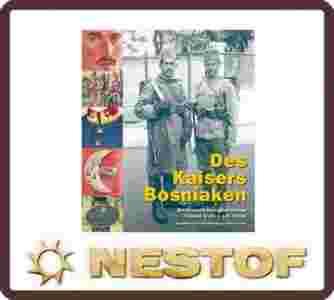OPIS
Przedmiotem aukcji jest monografia o Bośniakach w
armii austrowęgierskiej w latach 1[zasłonięte]878-19. Łącznie
352
strony, bogato ilustrowane ponad 600 zdjęciami.
Książka w twardej oprawie, dodatkowo w obwolucie. Poniżej przykładowe zdjęcia z
książki.
Autorzy: Prof. DI Hermann
Hinterstoisser, Erwin A. Schmidl, Christoph Neumayer,
Helmut Wohnout
ISBN: 978-3-9[zasłonięte]02526-8 (wersja
niemiecka), 978-3-9[zasłonięte]02526-2 (wersja bośniacka)
lub 978-3-9[zasłonięte]02526-5 (wersja angielska)
Waga: 3,00 kg
Dane Techniczne: 352 strony, ponad 600
kolorowych zdjęć, łącznie ze współczesnymi fotografiami
i ilustracjami, zszyte w twardej oprawie. Format: 29.5 x 26.0 cm.
•
Publikacja wydawnictwa Verlag Militaria, wysoko
cenionego wśród kolekcjonerów i hobbystów
• Książkę wysyłamy w terminie
14 dni
od zaksięgowania wpłaty lub 20 % przedpłaty w
przypadku pobrania.
• Po zakupie proszę o informacje którą
wersję językową wysłać!
OPIS ANGLOJĘZYCZNY
Bosnia-Herzegovina was occupied by
Austria-Hungary in 1878, annexed in 1908 and was
part of the Austro-Hungarian Empire until 1918. This
book, illustrated in colour, with
352 pages and nearly 600
photographs, presents a picture of the
Bosnian soldiers in the Austro-Hungarian army and
their military history under Austro-Hungarian
administration. Starting with the political and
military reasons for the occupation, through the
annexation to the end of the First World War, it
takes the reader to a world that at the time was
seen as highly exotic.
The Bosniaks, who were seen as an elite group within
the k.u.k. Army and who – with their strange
uniform and fez headgear – attracted much
attention from the various formations of the
Austro-Hungarian Army, are the focus of the book.
This richly illustrated volume also
offers a detailed view of the uniforms, equipment
and weaponry of the Bosniaks, from the formation of
the Bosnian-Herzegovinian infantry
and Jäger troops to their first deployment in the
First World War, 1914 –1918.
Finally, short biographies of numerous well-known
people who served with the Bosniaks, for instance
the once Austrian President, Dr Adolf Schärf, give
the Old Army a face.
Feared by their enemies, respected by their comrades
for their fighting spirit, the
Bosnian-Herzegovinian troops were a
reliable component of the Austro-Hungarian Army
until the end of the First World War.
This book, produced in co-operation with the
Heeresgeschichtliches Museum Vienna, the Austrian
Federal Armed Forces and the Army Museum Budapest,
as well as private collectors, is also a project
intended to bring together different religious and
ethnic groups.
OPIS NIEMIECKOJĘZYCZNY
Bosnien-Herzegowina wurde durch Österreich-Ungarn 1878 (
vor 130 Jahren) besetzt, im Jahr 1908 (vor 100 Jahren)
annektiert und war bis 1918 (also vor 90 Jahren) Teil
der Donaumonarchie. Dieser 352 Seiten
und fast 600 Fotos umfassende
Farb-Bildband gibt einen Überblick über die
Bosniaken in der österreichisch-ungarischen Armee und
ihre militärhistorische Vergangenheit unter
österreichisch-ungarischer Verwaltung. Beginnend bei den
politischen und militärischen Hintergründen für die
Okkupation über den Verlauf der Annexion bis hin zum
Ende des Ersten Weltkrieges führt Sie dieses Buch in
eine damals als exotisch geltende Welt.
Die Bosniaken, die in der k.u.k. Armee als Elite galten
und die von den vielen Einheiten der
österreichisch-ungarischen Armee wegen ihrer
Uniformierung – mit dem Fez als Kopfbedeckung –
besonderes Augenmerk auf sich zogen, stehen dabei im
Mittelpunkt.
Dieser reich illustrierte Bildband gibt aber auch einen
detaillierten Einblick in die Uniformierung, Ausrüstung
und Bewaffnung der Bosniaken, von der
Aufstellung der bosnisch-herzegowinischen Infanterie-
und Jägertruppen bis hin zu deren Einsatz im
Ersten Weltkrieg 1[zasłonięte]914-19. Weiters
verleihen Kurzbiographien von namhaften Persönlichkeiten,
die bei den Bosniaken dienten, wie z.B. dem ehemaligen
österreichischen Bundespräsidenten Dr. Adolf Schärf, der
Alten Armee ein Gesicht.
Vom Feind gefürchtet, von den Kameraden wegen ihres
Kampfgeistes geschätzt, waren die
bosnisch-herzegowinischen Truppen bis zum Ende
des Ersten Weltkrieges ein verlässlicher Bestandteil der
österreichisch-ungarischen Armee.
Das Buch – erstellt in Zusammenarbeit mit dem
Heeresgeschichtlichen Museum Wien, dem Österreichischen
Bundesheer und dem Armeemuseum Budapest sowie privater
Sammler, versteht sich insbesondere auch als religions-
und völkerverbindendes Projekt.
OPIS BOŚNIACKOJĘZYCZNY
Austro-Ugarska je 1878. zauzela Bosnu i Hercegovinu,
1908. Bosna i Hercegovina je anektirana i ostala je
dijelom Dunavske monarhije sve do 1918. Na 352 strane sa
skoro 600 fotografija ova monografija u boji daje
opširan prikaz Bosanaca i Hercegovaca u austrougarskoj
vojsci i pruža uvid u period kada se Bosna i Hercegovina
nalazila pod austrougarskom upravom. Knjiga se osvrće na
političku i vojnu pozadinu okupacije i čitaoce vodi
preko perioda austrougarske uprave i aneksije pa sve do
okončanja Prvog svjetskog rata, koje je u isto vrijeme
označilo i kraj austrougarske epohe u Bosni i
Hercegovini. U središtu pažnje stoje Bošnjaci – kako su
nazivani u to vrijeme – koji su sačinjavali elitne
formacije austrougarske vojske i koji su baš zbog svoje
karakteristične uniforme – fesa kao kape i tipičnih
hlača ispod koljena – privlačili posebnu pažnju mnogih
drugih jedinica austrougarske vojske. Ova bogato
ilustrirana monografija daje i detaljan uvid u vrste
uniformi, opreme i naoružanja Bošnjaka, od rasporeda
bosanskohercegovačkih pješadijskih i takozvanih lovačkih
trupa pa sve do njihovog angažmana u Prvom svjetskom
ratu 1[zasłonięte]914 19. Knjiga donosi i kratke biografije
značajnih ličnosti koji su služili kod Bošnjaka, kao što
je to bio slučaj s kasnijim predsjednikom Savezne
Republike Austrije dr. Adolfom Schärfom. Ove ličnosti
podarile su bosanskohercegovačkim trupama u staroj
austrijskoj vojsci jednu novu dimenziju. Kulturni i
industrijsko-historijski aspekti zaokružuju ovu tematiku
– kuriozitet toga vremena bila je činjenica da je
Austro-Ugarska u 19. stoljeću bila najveći proizvođač
fesova u svijetu!
Neprijatelj ih se bojao, drugovi su ih cijenili zbog
jakog borbenog duha – bosanskohercegovačke trupe bile su
do kraja Prvog svjetskog rata legendarna sastavnica
austrougarske vojske. U svjetlu posljednjih ratova u
jugoistočnoj Evropi ovo djelo podvlači zajedničku
prošlost svih naroda i vjera u Bosni i Hercegovini.
Nastalo je uz pomoć opširne dokumentacije i dokazane
saradnje s Vojnohistorijskim muzejom u Beču, Vojnim
muzejom u Budimpešti i Vojskom Savezne Republike
Austrije kao i podrškom privatnih sakupljača.
GALERIA
[Kliknij na zdjęcie żeby powiększyć]






| | |

